There are many reasons why outreach emails get to be deleted directly without even being read. One of the reasons is that they are never read; not even by the person who wrote them. Therefore, when the sender is not even trying to be coherent or make any sense, why should I be the one trying to read its messages?
Moreover, how can I not delete your emails if they bring me no added value? None. Except the astonishment of how unprofessional that email is written, it literary brings me nothing. As an irony, it claims to get me a lot of worth (ranking no. 1 on Google and trillions of unique visitors on my website, just to mention some) but actually, there is nothing in for me.
And how can I not delete your emails when you advertise me things I am totally unrelated to, you are not even trying to connect at a personal level, or you try to schedule appointments without me knowing what for.
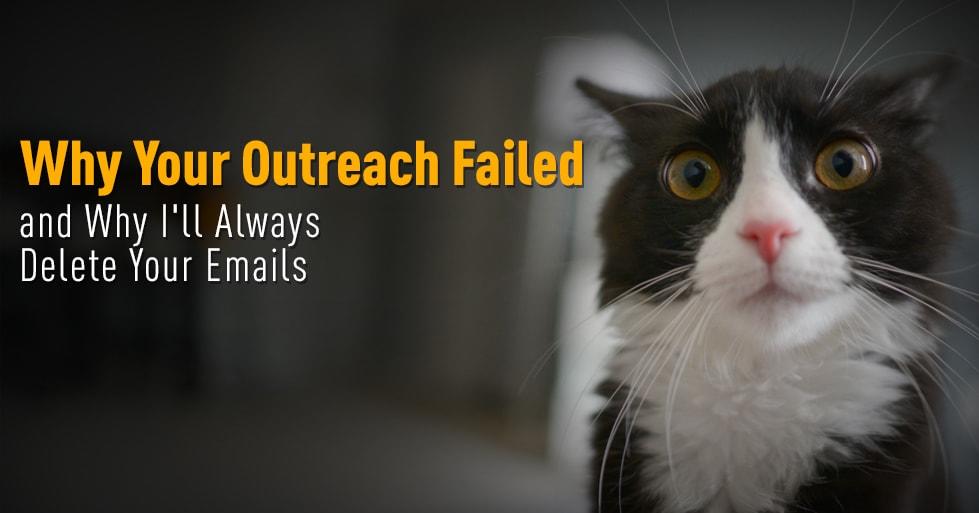
I am not replying to these failure emails because replying to them might give someone the impression that their emails were well written, they lead to engagement, and they drove results. And that is the last thing I wish to do.
Every time we get a bad outreach email we think ’Oh, I’ll definitely write a post about it someday soon’. But so it happens that we don’t have the time to treat them individually. We gathered the main lessons we’d love to leave as SEO legacy from the over 10 k outreach emails we received, over time, to offer you an idea of what unprofessional propositions look like. From link exchange, guest posts to black hat collaboration, there’s no unsuccessful proposal that escaped our inbox during the last years.
We believe that outreach marketing is best done through human outreach – creating valuable relationships with people in your network, with the purpose of exchanging professional experiences.However, in this article we’re going to present you the opposite of that. As we’ve received over a thousand outreach emails in time, we decided to gather a list of lessons we learned in time. We will present to you some of the most frequent and serious mistakes we found with the outreach emails we received over time. Aside from making a list, we also tried to break them into the most relevant categories.
- Be Specific When You Write an Email
- Be Consistent and Eloquent or You Won’t Get a Reply!
- Never Advertise Your Prospect’s Competitors
- Avoid Generic Formulas that Lack Personality
- Don’t Harass Your Prospect! Be Flexible and Patient
- Don’t Take Your Prospect’s Reply for Granted! Prove Yourself Worthy of a Connection!
- Don’t Insist Too Much or Your Prospect Will Tag You as Spammy
- Don’t Send the Same Outreach Templates Over and Over
- Don’t Overuse Textual Emphasis Features
- Be Concise. Spare Your Prospect the Huge Block of Text
- Don’t Give the Idea that Your Email is Spam!
- Target a Specific Audience or You Won’t Be Remembered!
- Keep Relevant! Avoid Long and Generic Content
- Stress On the Added Value of Your Proposal!
- Fix the Broken English – Sloppy Content Is Not an Option!
- Offer Something Meaningful Before Asking for Favors
- Be Clear About Your Intentions. Shady Tactics Don’t Work with Professionals
1. Be Specific When You Write an Email
You’d think it’s almost redundant to say, let alone stress, that researching is crucial before an outreach campaign.
You cannot simply email the same template to 200 people and hope for the best.
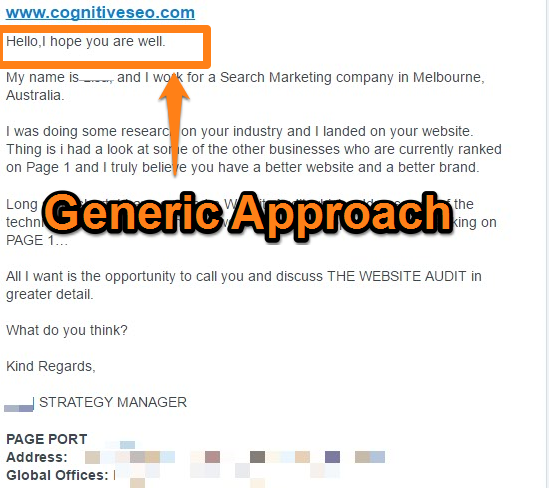
First of all, no influencer will read an email further than ‘Hello, I hope you are well.’ Who am I? Do you even know the type of business I’m running? I believe not. What gave you away?
You cannot simply offer to give me a service that I’m into the business of offering too. It’s not ‘unprofessional’. It’s more than that – it’s outrageous and messy not to know who you’re talking to.
2. Be Consistent and Eloquent or You Won’t Get a Reply!
Before anything approach-related, a quick technicality: You can decide either to write your message subject with capital letters or not. A middle way is not professional.
Concerning the email. First of all, having typos inside the ever-so-short outreach email is not quite professional. It means you were in a hurry.
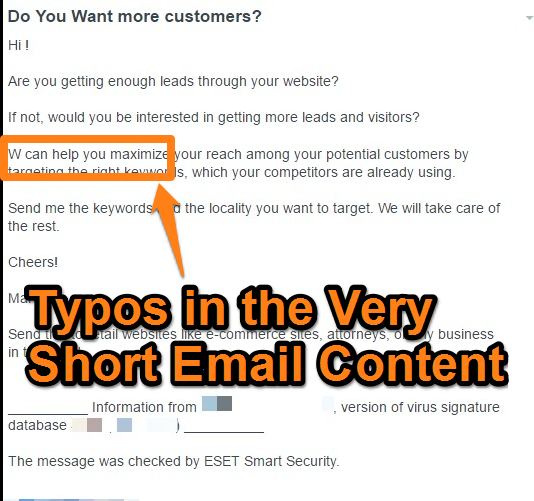
It’s hard to assume that somebody who doesn’t even bother to write both letters in the word ‘we’ has actually conducted a thorough research on our business before contacting us.
A smartly put marketing-based approach could have spiked the interest of any SEO professional out there. Yet, it doesn’t take in-depth research to notice that we also offer a rank tracking module – helping our customers constantly monitor their rankings.
Actually, one only needs to access our site.
In this context, asking us to use another service for better rankings is too much. Not to mention that this approach, from a knowledgeable professional to another, may have worked if it had been based on a very specific piece of context.
For instance: ‘Hi, Razvan. I also have an SEO tool and I noticed that your rankings dropped for the x keyword last week. Just wanted to friendly let you know.’
Tip: It’s not advised to write to the owner of a comprehensive SEO tool explaining in broad terms what the SEO activity is about.
Assuming you should spend at least 5 minutes on a website before emailing to whomever (it’s not certain from the email body), you should know what their activity is about.
Not to mention how demeaning it is to offer to do our job for us. Clearly an awful example of spammy outreach.
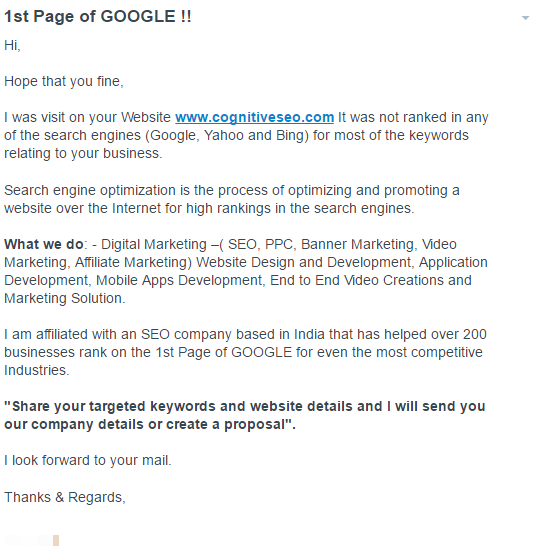
3. Never Advertise Your Prospect’s Competitors
We’re not proposing an all-night-reading-our-blog-inside-out. We’re talking minimum facts, such as our website being a platform that advertises our SEO tool, which happens to be one of this proposition’s competitors.
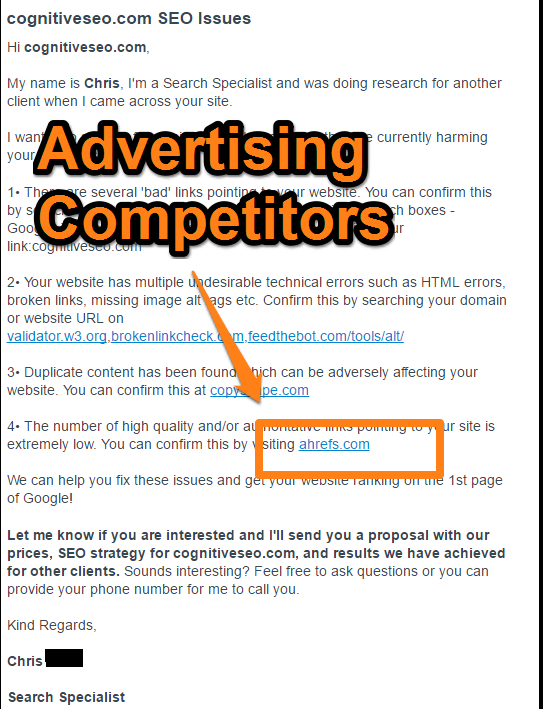
Despite being a little rude and uninformed, the guy is also sending a generic message that says nothing about our site at all. It does present a large array of possible issues of any website out there. How convenient, right?
There’s a reason why the spammy strategy doesn’t work. It is true. You can do a lot of documentation and come up with 20 great emails, both relevant and personal or you can send 500 random spammy texts.
It is also true that, most likely, each of these times only 5 of the webmasters will reply to your email.
What makes the difference is the type of connection you’re making and its relevance for your business. These outreach campaigns – whichever their purpose – are meant to enhance our marketing efforts and engage a new audience through the means of an influencer. And it’s only the first of these techniques that will lead you there.
4. Avoid Generic Formulas that Lack Personality
Quite the same issue as the other emails had. Add a plus of bullet-ed list, that makes the inappropriate email easier to read – to make sure that we understood how they did not bother to read about us. The main issue of this approach is that it fails to address us personally. Most of the marketers out there don’t have the time to reply to senders who weren’t even interested to be personal.
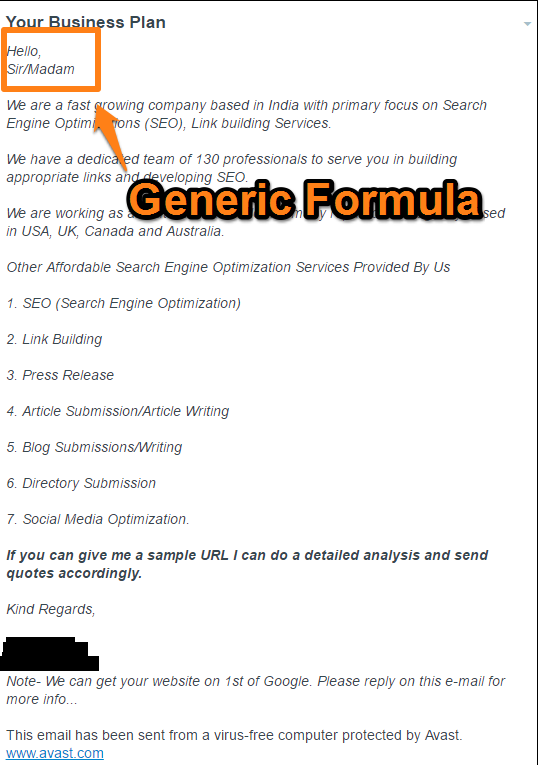
On a more serious note, the most damaging fact about writing such an email isn’t the email. It’s not even the fact that you won’t get a reply. It’s that not only have you failed win a connection, but that you have forever lost it.
These days, when you talk to a person you talk to one thousand. You cannot afford to ruin your reputation before even having one.
Anyone receiving this email will put you on a professional blacklist where you’ll either be quoted as a bad example (guilty as charged!) or you’ll just be forever ignored.
Maybe your business has just started and you’re not familiar with these common sense rules. Maybe in 5 years’ time you’ll be more mature and looking to increase your network. Some of the people will never get over the fact that you’ve once been this sloppy.
There’s a broad category of people who will not take no for an answer. While generally in your professional life this isn’t a bad thing, it also depends on how you’re putting it.
However, you can’t just endlessly send automated emails without understanding that a lack of an answer has its reasons – usually the fact that you did it wrong the first time.
5. Don’t Harass Your Prospect! Be Flexible and Patient
When you’re used to dealing with professionals, it’s intolerable to see stubborn attitudes accompanied by no concept/content.
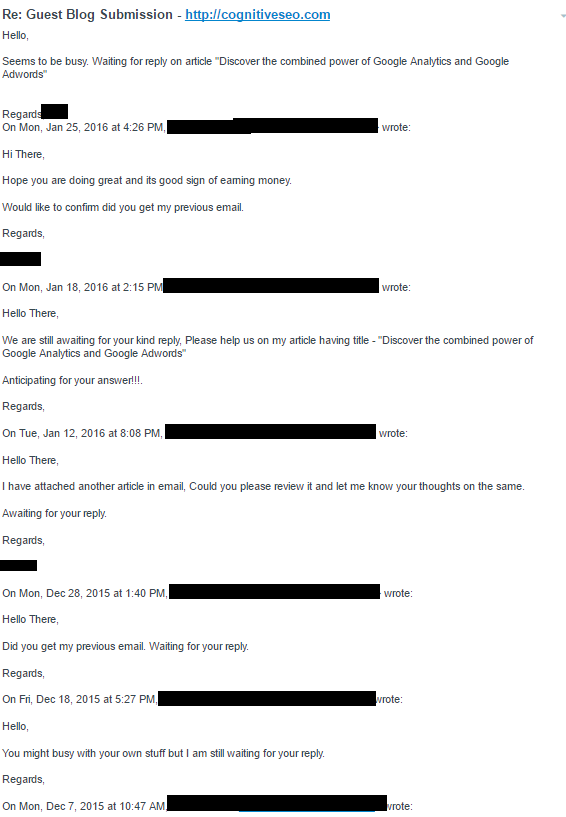
The example above refers to a person who sent us over 30 emails in approximately one year – none of which got a response. This, however, didn’t make any bell ring. Borderline harassing, this attitude will bring you no luck with a webmaster.
We’re all for follow-ups. Every business relationship has to be maintained properly and won’t, supposedly, limit to one or two interactions. But sending a ton of follow-ups – that are most likely automated – while repeating the same mistakes clearly won’t get you too far.
6. Don’t Take Your Prospect’s Reply for Granted! Prove Yourself Worthy of a Connection!
Maybe the most important observation about this outreach email isn’t even that it comes from someone so insistent.
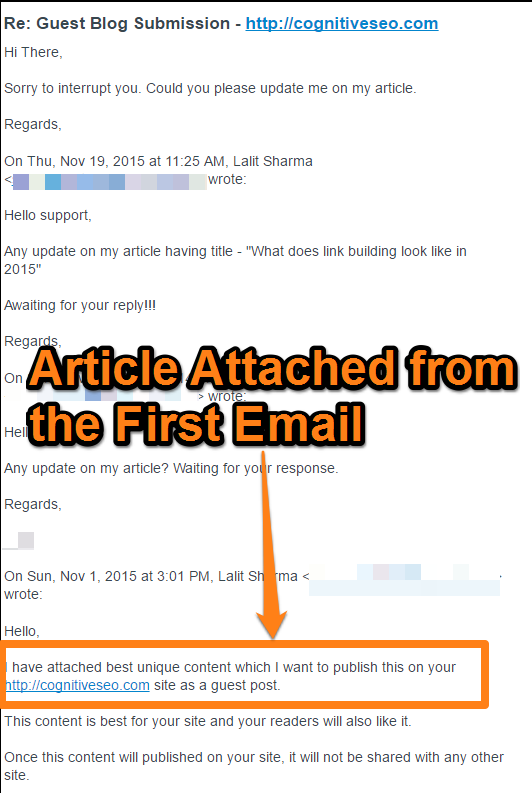
We believe that every reaction (or lack thereof) has its cause. The main cause why we didn’t reply to this person is that it’s such a bad practice to send entire article, already written on a topic of your choice, on your first outreach email.
It says a lot about not being available for longer talks in order to provide a truly appropriate topic to write on. It also shows lack of flexibility (of course, assuming it wasn’t a bulk message, case in which it is way worse).
You cannot do this for a good number of reasons:
- You can’t know weather the webmaster is really interested in a guest post on his blog. The more professional the webmaster, the slimmer the odds;
- It’s not professional to assume that the webmaster will be interested in that specific domain – let alone ‘serve’ an article already written. Most of the website admins will at least impose a few conditions. Sending an attached post is almost a guarantee you won’t be taken seriously;
- The topic of the guest post is usually something you negotiate with the webmaster, assuming – of course – you’ve been decent enough as to get a chance to publish on your prospect’s blog;
- Take the sentence ‘I have attached best unique content which I want to publish this on your site as a guest post’. It’s not just poor phrasing and contextualizing. It’s broken English – the new low in any professional industry of your choice. Moreover, this email being about your content writing qualities, how could anyone ever trust your content creating rigor when you didn’t get the 2 sentences right?
7. Don’t Insist Too Much or Your Prospect Will Tag You as Spammy
This is perhaps the most fascinating example of this article. These people think we’re interested in their LED factory’s products.
They’ve sent us countless emails, with different texts and approaches, from different email addresses, through time.
Each one of these emails had something DIFFERENT wrong with it.
This one, for instance, used the very off putting ‘dear sir/madam’ formula. Also, the text of the email was quite telegraphic for someone who’s been emailing us for months.
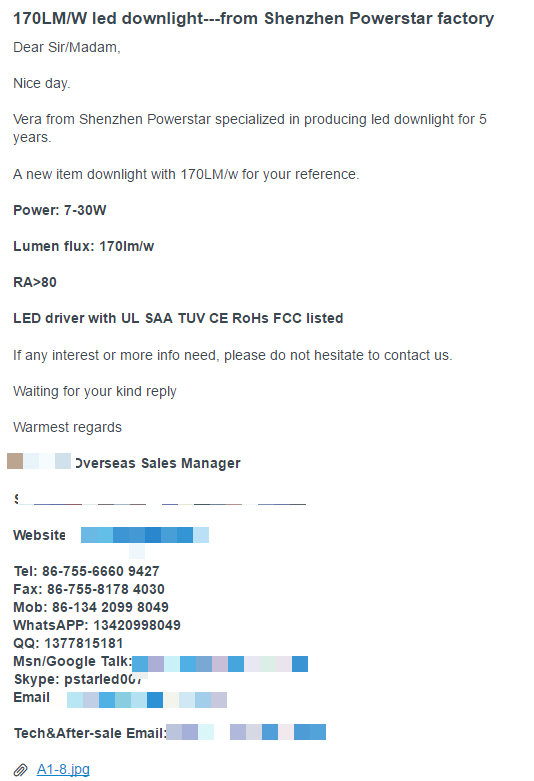
So many wrong things here:
- The ‘Hi, dear’ formula, that’s never appropriate in a professional environment;
- ‘We found you here and know that your are business on LED products also. We are one. ’ – aside from the poor English (and I also mean it in the compassionate sense- a bit smart ass), there’s no true fact there aside from them producing LEDs. Also, we’d be curious to find out what ‘here’ is in reference too;
- Concerning the style, the paragraphs are discontinuous and broken off, clearly not sending a favorable message, even assuming the content would have been more appropriate to our field;
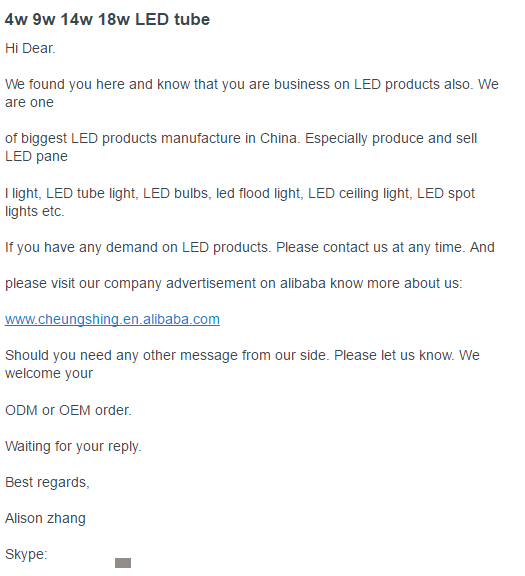
Aside from the other issues we’ve analyzed until now, there is something outstanding about this particular message.
This was perhaps the 20th message we got for a business proposal, throughout a year. It means the people running this company certainly have a marketing department: one that stores data about their network and analyzes the market and, sadly enough, composes the texts they’re sending out.
One of the most scaring risks you’re taking through sending an unprofessional outreach email is having people believe that your entire company’s marketing efforts are based on random approaches instead of coordinated effort. Long term, this can cause serious brand management issues that can lead to significant loss in profit.
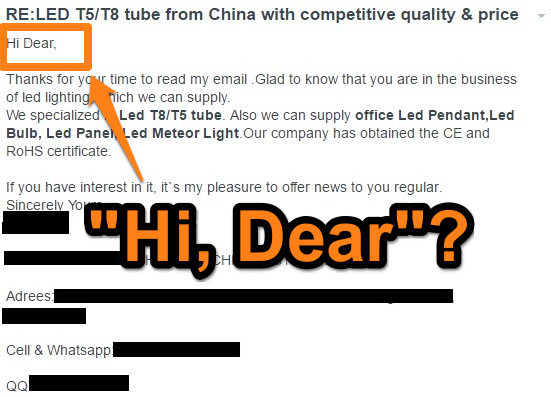
8.Don’t Send the Same Outreach Templates Over and Over
It’s true that the sir/madam line isn’t the most inspiring. But that’s not the most off putting about this email. It’s being entirely generic what makes it inappropriate.
If your email works just as well if I’m the SEO industry or if I’m selling pipes, maybe you’re doing it wrong. This ‘Hi, your blog is informative, fun, inspiring and eye-opening’ approach doesn’t work in a competitive industry.

And it’s far from over. Add being insistent to this mix and you’ve got yourself the worst guest post pitch possible. Not to mention that the phrase ‘Thank you for your consideration’ should imply we’ve already answered to your thousand emails – which is both false and annoying.
It also suffices to say that the emails we published in this article are just a few of the instances this person approached us.
9. Don’t Overuse Textual Emphasis Features
One of the issues of emails containing huge blocks of text is the amount of content written. Textual emphasis is generally used to shift the attention on the most valuable idea you’re pitching. When you overuse it, the entire email will look sloppy and spammy.
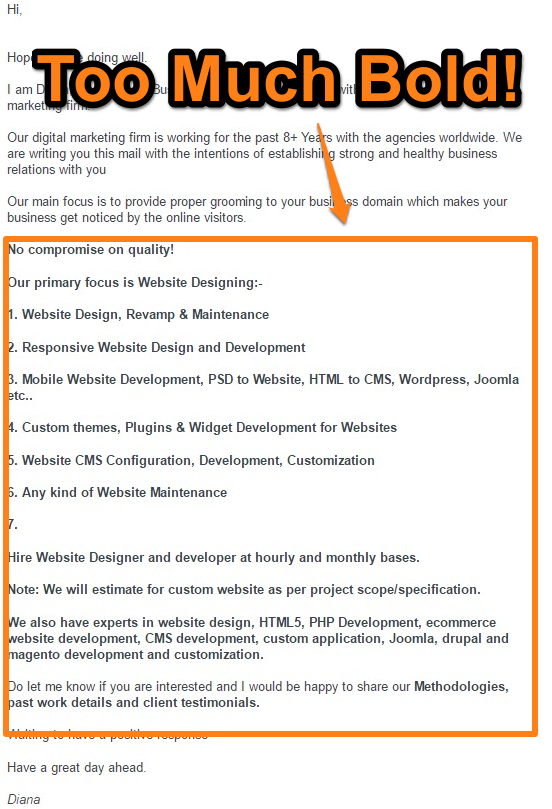
And there is more than one other reason why we wouldn’t recommend this type of outreach.
- Promotional outreach is too much. People barely read your emails when you’re giving them heads up about their own issues. Nobody will be kind enough with their time as to read something promoting your business in their free time. And supposing we would need this company’s services, outreaching just to make themselves known is very intruding in terms of marketing strategy;
- Not being specific enough. Aside from not knowing my name (which literally would have taken a few seconds), the email doesn’t even seem to offer something specific – a bunch of generic services doesn’t mean walking an extra mile. Carefully researching as to propose something of true relevance for the influencer does;
- It doesn’t offer competitive advantage. That’s the worst that could possibly happen in this very competitive environment – especially online, where there are no other boundaries but the quality of your services and how you’re pitching them. Other than (not satisfactory) covering the informational part, this email doesn’t stand out by anything.
10. Be Concise. Spare Your Prospect the Huge Block of Text
Looking at the email below, other than having wording issues, you’ll believe it’s decent. Of course, not one of the ones you actually ANSWER to, but not to be presented on a negative list either!
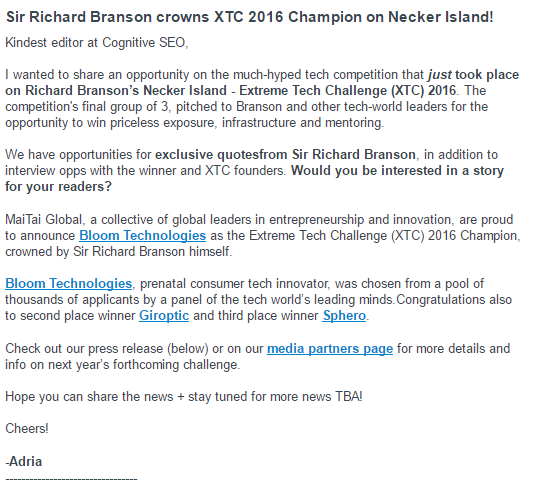
And then comes a huge block of text just below the signature. Psychologically, when sending an outreach email you have to ease the influencer into participating/responding/doing something.
This is one of the poorest examples. Besides not having a good chance with the email copy per se, this huge press release attached is a major turn off, even assuming that you’d initially be inclined to answer.
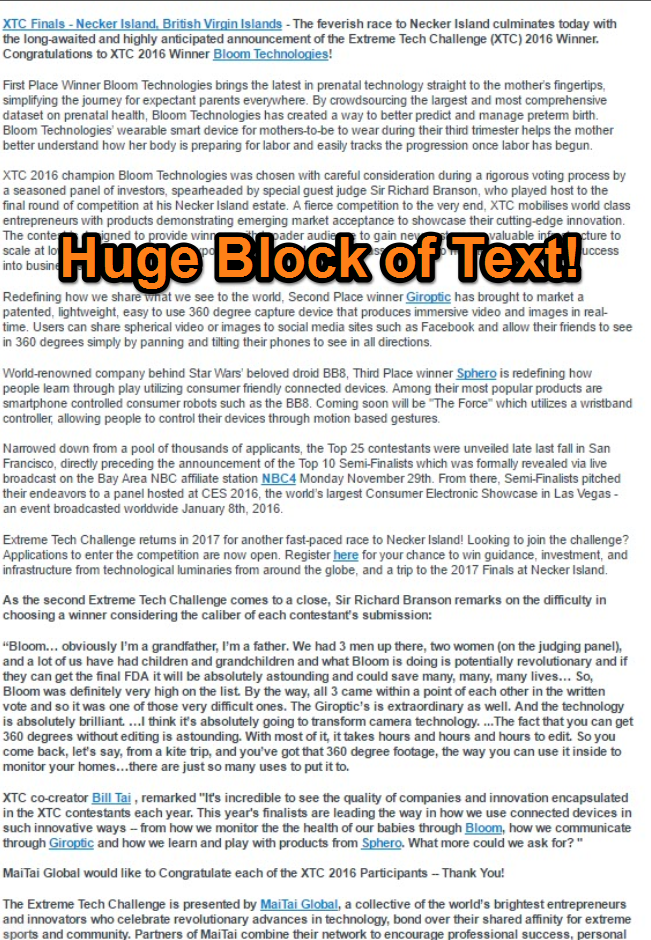
11. Don’t Give the Idea that Your Email is Spam!
The fact that this email is long and not at all specific somehow weighed so much because it was so diluted and irrelevant. This P.S. also indicates that there is a high chance for it to be spammy.
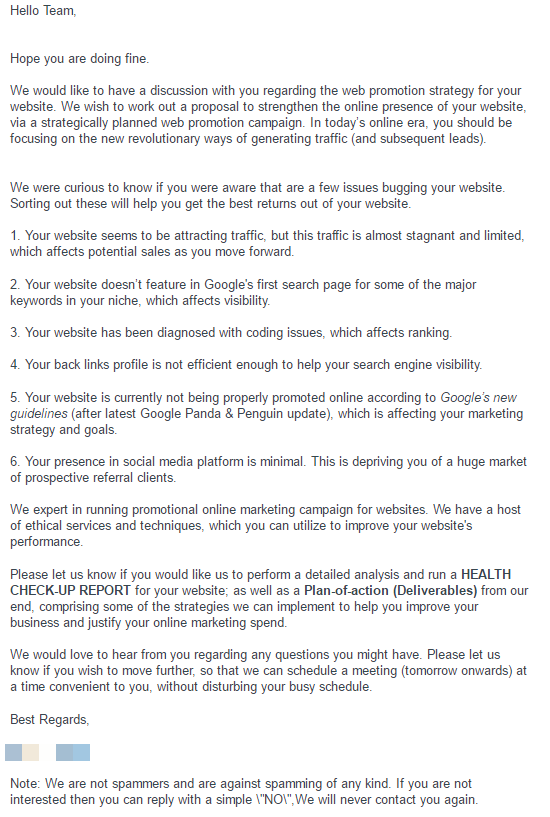
The need to integrate this final disclaimer comes from the lack of planning in designing the outreach campaign, along with the recipients who were destined to receive the emails, and the lack of research as well.
12. Target a Specific Audience or You Won’t Be Remembered!
Offering such a wide array of services should be accompanied by targeted promotion for each of them. Accordingly, every single service should have its own targeted audience, and they shouldn’t be mixed all together, but two or three of them exceptionally.
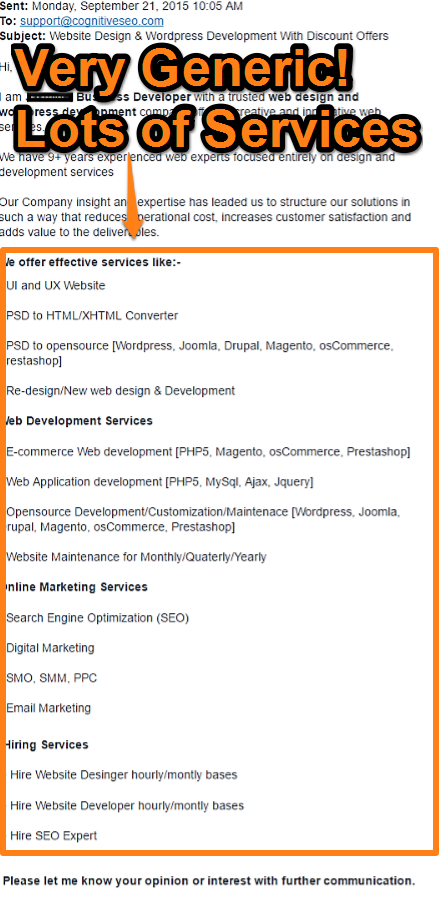
However, emailing an influencer to let them know about all these services is an unfortunate strategy for the following reasons:
- It doesn’t allow the receiver to focus on any of these, since they’re too many;
- Assuming the influencer would be interested in one of these services, they would still ignore the emails since the services are advertised together;
- It doesn’t allow focusing on the competitive advantages of his business because of the information vertigo.
13. Keep Relevance! Avoid Long and Generic Content
In this example, we’re going to skip the ‘not-knowing-my-name’ and ‘offering help in my area of expertise’ issues, to address even more important ones.
The email is way too long.
We believe there could be successful blog posts shorter than this. First of all, nobody will give you credit for a ‘unique strategy’ that isn’t that unique in the first place, and that you’re not even a little reluctant to present even before knowing my name. The ‘buy-me-dinner-first’ rule applies.
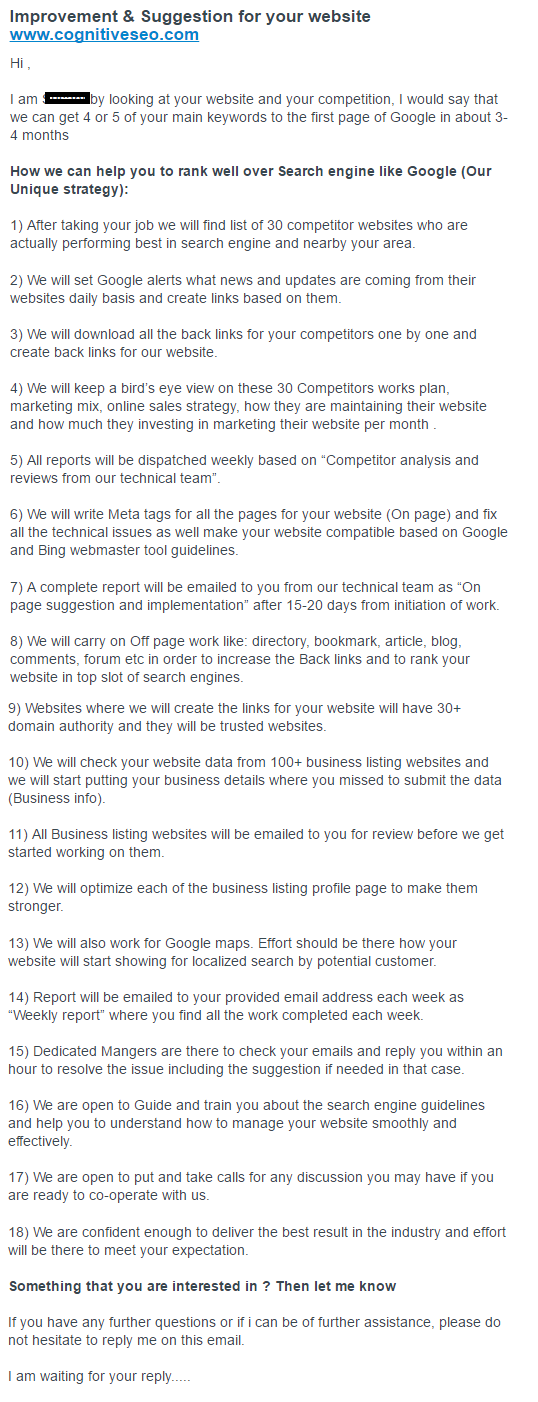
Usually, this kind of proposition requires intensive previous talking about the specific industry that we’re active in, the size of our business etc. assuming this wouldn’t be the same you’re advertising for.
Last but not least, it’s absolutely redundant to just go through all the steps of getting better ranking, traffic, visibility on social media platforms etc. Instead, a more concise approach to sum up the major benefits of these steps would have made a much more powerful approach.
14. Stress on the Added Value of Your Proposal!
We’re positively certain that it wouldn’t have taken more than 40 seconds on our website to realize that your public is not very successfully chosen. In our blogging history, we haven’t ever published something similar. Moreover, we rarely publish infographics, and assuming we’d be open to let this situation change, it would take something that’s truly specific and relevant to both our niche and the audience that usually reads our content.
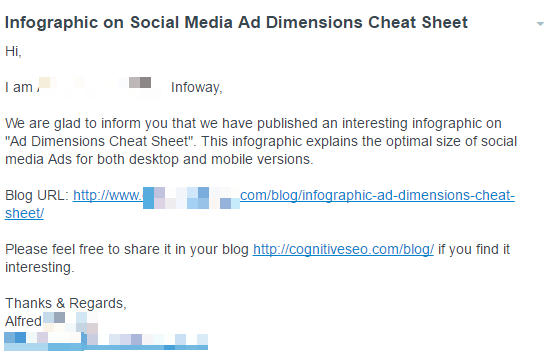
Aside from this, the same mistake as sending out an already written guest post is made. You cannot just attach an infographic that is not even related to my business and then hope we’re going to publish it on our blog.
15. Fix the Broken English – Sloppy Content Is Not an Option!
This is one first examples of sloppy content. Very generic, it works perfectly in the fashion world as well as it does in retailing. You cannot afford to be this evasive in your approach, which should be all about convincing you’re worth taking into consideration as a contributor.
The nature of this context imposes the rigor of relevance, as well as a sense of personality casually slipped into the conversation. The email below fails to offer any of these.
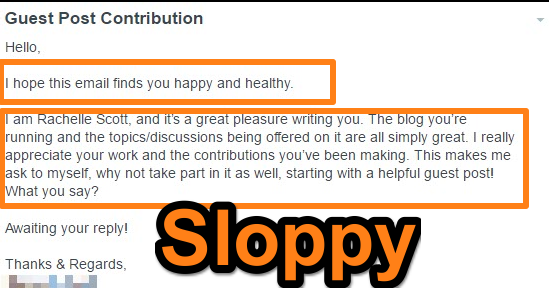
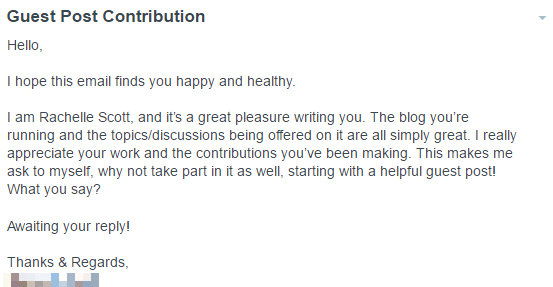
This email is differently generic than the previous one. This one tries to achieve a more personal endeavor. However, it fails to address my name, and it also contains superficial wording such as ‘frequent visitor of your blog’.
Moreover, I would place a bet that Phillip didn’t even enter our blog once. If he had, he would have known that we don’t cover graphic design among our topics, that our case studies mostly conduct other kinds of analyses.
Of course, besides the huge mistake of offering to send us an already written guest post on a topic of his choice.
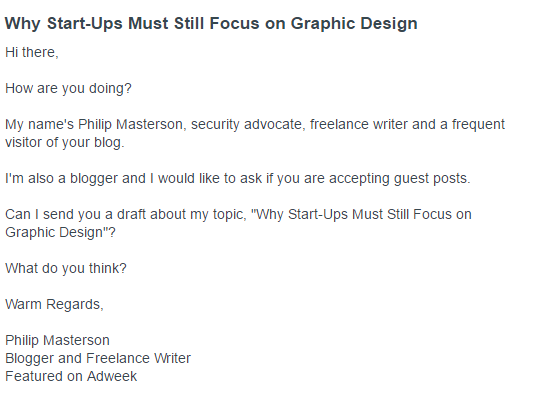
Before even trying to think of a specific competitive advantage, get your facts straight – that is not our infographic. The email had already started bad with the ‘sir/madam’ formula. Further, making an offer based on a false premise is quite the path to failure.
Plus, being so generic as not to mention anything related to our area of expertise makes the entire proposition futile.
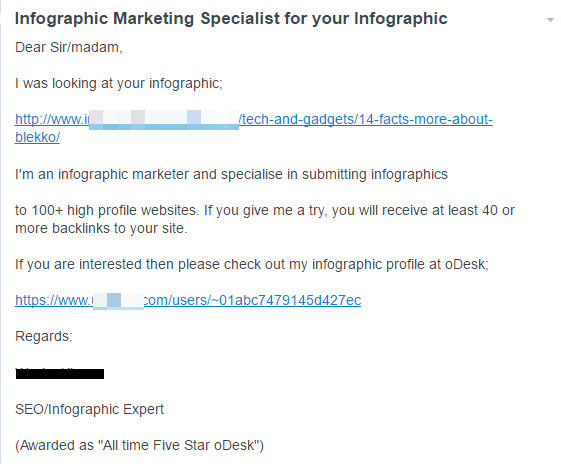
The ‘I need your help’ approach is usually accompanied by ‘you’ll also have advantages’. While the others are only generic and non-personal, this email is vague and it needs extensive conversation.
When addressing somebody who generally lacks time because of the industry, the idea is to be catchy and promising from the first attempt. Whenever you fail to do this, the chances to ever get a response are significantly slimmer.
Plus, just stating you are a student won’t make the prospect accept your offer just because your assumed intentions are good. It takes more than that to be taken into consideration as a professional (be it budding).
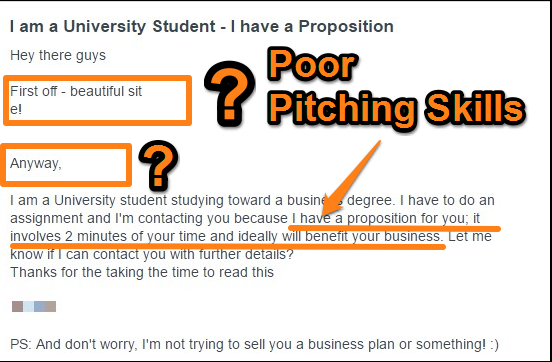
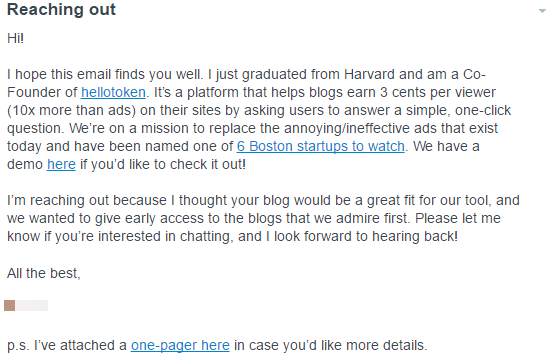
The entire idea behind this email is odd. It begins with ‘you’re a professional, your articles were useful during my documentation’ and it ends with ‘I’m equally capable, let me write for you’. If you’re casually ‘looking for some information on creating backlinks’ one morning, this doesn’t represent a savvy approach that could bring you a high response rate.
In other words, don’t make the approach so thin when it comes to the idea behind it. Creating a scenario often comes in handy, as it places our relevance in your professional life and it gives us a good start.
However, superficial readings don’t make profitable conversation starters.
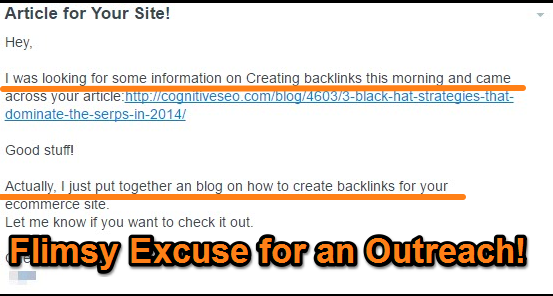
Perhaps the worst kind of outreach failures come from people who have the potential to write something worth your while. It doesn’t seem like we do accept guest posts on a regular basis, we never gave this idea to anyone. On the contrary, just like anyone else who’s a professional in this industry, we’re very careful with the guest posts we’re accepting.
Anyone who pitches you an idea should know this, especially if they’re ‘an avid blogger’.
Another mistake is presenting examples of your content, using broken English. A sloppy email will fail to generate a good response rate. It’s impossible not to see the mistakes before anything else, especially since you’ve been spending years trying to build an eye for identifying them.
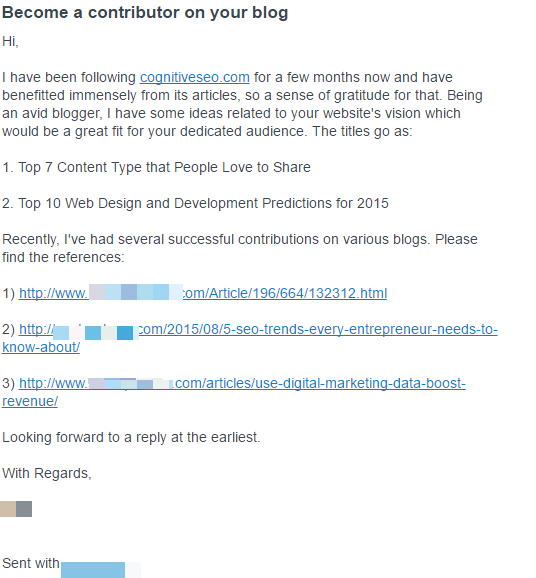
First off, for somebody who benefits of a large professional team, you sure missed your research. It’s unacceptable to call us ‘cognitiveseo.com’. It lacks seriousness and gives away your generic approach.
Second, it wouldn’t kill seeing who you’re writing to, as it’s almost embarrassing to receive an offer from someone performing the same type of services as you do. It’s like telling you you’re not doing your job well. And I don’t mean ‘you missed a little something here’.
That’s a friendly approach, very specific and it shows investment, as it took time to come across it. On the opposite side, there’s the very wide email we received from somebody who wishes to make a link audit on our website.
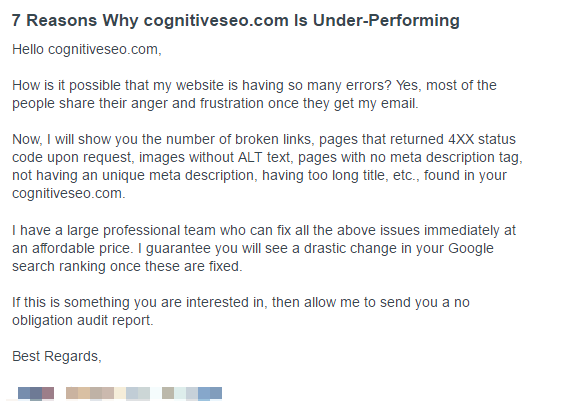
16. Offer Something Meaningful Before Asking for Favors
Some of the email senders have no real motivation for which you should do them favors. No elaborate explanations, not one good, specific reason. Just because they’ve got a business and you’ve got a business and you seem to have exposure. This is as far as the thought process goes.
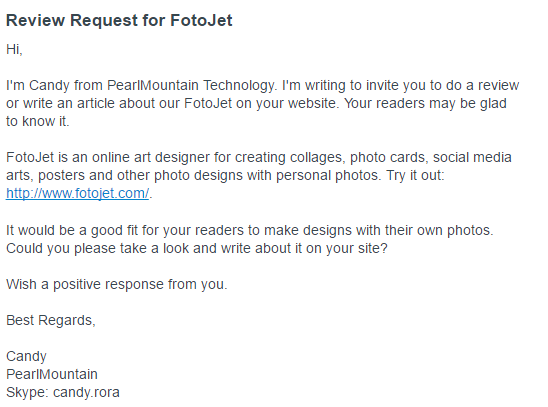
The only benefit presented in the email is our readers, happy to take advantage of their products. However, while this is necessary, it may not be enough of a premise to accept the featured guest post.
This shows a huge leap of faith in the outreach campaign, which most of the times won’t bring the desired results. Instead of being specific and to the point, this email has just managed to leave us extremely disappointed.
Needless to say, the broken English didn’t help much, either.
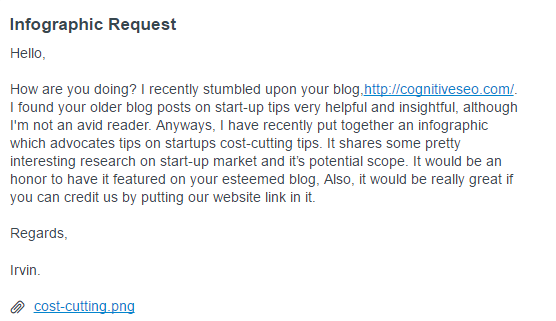
Reading this email really made me wonder if before starting the outreach campaigns they read about the business. Because, regarding this example, my instinct suggest ‘not really, no’.
Secondly, let me walk you through how inappropriate this request is. To us, it’s the equivalent of knocking on a stranger’s door at 4 a.m., casually asking if they’re not interested in holding your huge wardrobe for a while – you’re sure they’ll benefit from it, and their friends will like it too, when they’ll visit.
A write-up in this industry takes a lot of effort. Because we’re aware how complicated it is to have a sustainable strategy when it comes to your website’s profile, we’re often reluctant to reply to people who take it so easily.
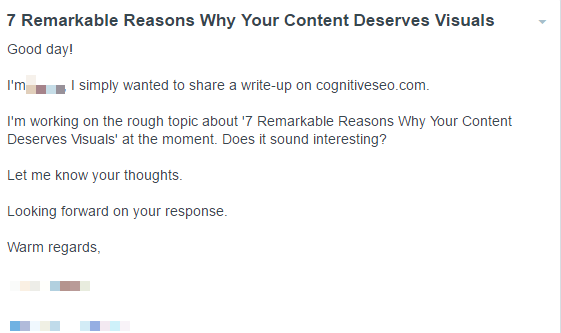
17. Be Clear About Your Intentions. Shady Tactics Don’t Work with Professionals
The reason why webmasters stopped hosting paid articles on their blogs lies in the guidelines of being a good professional. When quantity and not quality is the purpose, you will be careless about professional standards. This kind of situation often escalates from a nice bonus that comes with a niche article to publishing something so far from your website’s area of interest that affects your rankings.
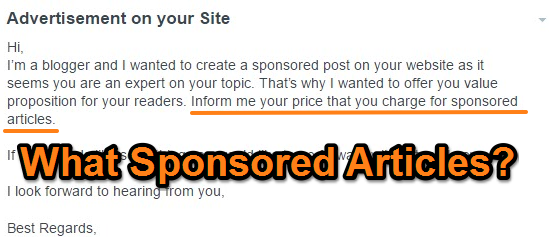
When they first noticed how dangerous of a slippery slope this technique is, people in the industry all stopped using it as a perk. Today, a few years after that, it’s almost outrageous to receive an email proposing to exchange money for content hosting and links.
It is very similar to how we’re socially perceiving actions and activities happening in the Middle Ages (and, from an evolutionary standoff, 4-5 years ago were the SEO’s Middle Ages. Under no circumstance would we allow anything similar to happen and whoever tries to advocate such practices loses all credibility.
There are some people who lack SEO perspective. Sometimes a proposition like this one sounds so unacceptable because it’s far from being done properly. I can’t remember the last time I’ve seen/read/heard of some similar strategy that actually worked, assuming that at least one of the parties was a trustworthy professional.
And it’s not just ignoring some of the search engine’s guidelines. Accepting such a proposition is giving up your efforts’ sustainability that took you years of hard work to implement.
Whenever it comes to avoiding SEO violations, I believe that the guidelines mean something a little different than linking to a partner site instead of yours directly. However complicated it is for a search engine to detect these techniques, it’s always best to keep it White Hat.
There are other reasons, aside from being a true professional, for which these practices shouldn’t be encouraged. Let’s all agree for a second that our main purpose is to satisfy an audience through the means of our content.
While generally it’s quite complicated to raise to the standards as it is, being shady with our links and sources clearly would generate solid traffic loss, implemented long-term.
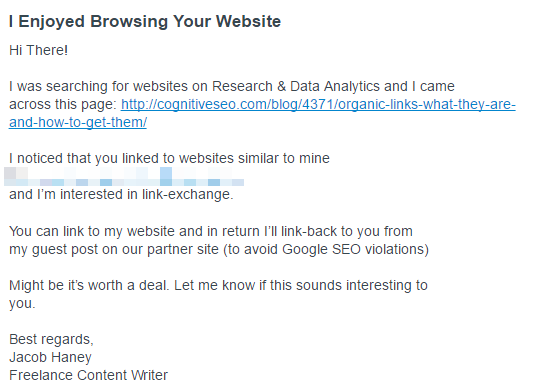
What’s even sadder about these practices is that they’re so common, they’ve got intermediaries.
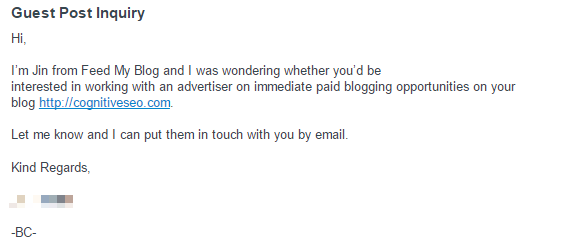
And they’re insisting.
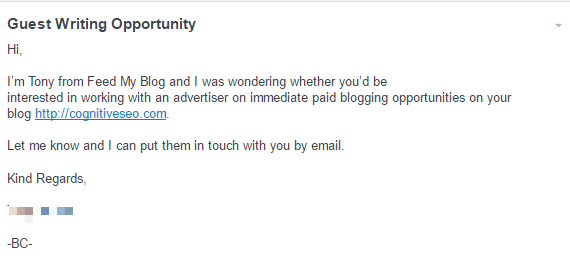
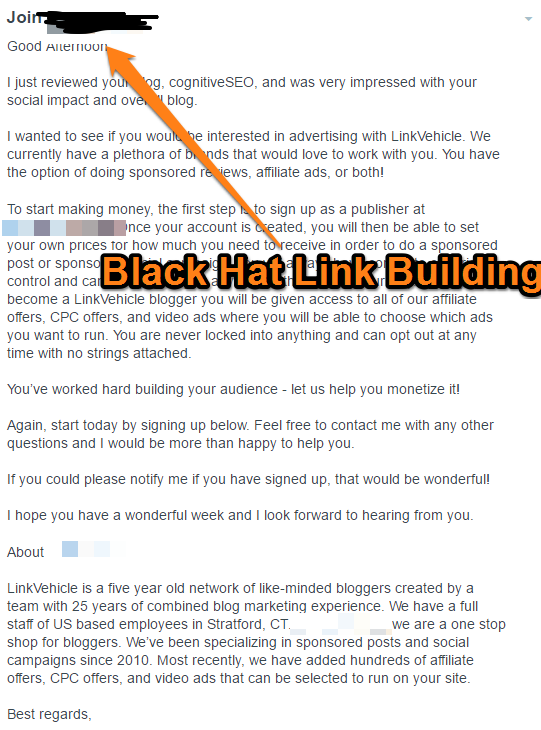
On the one hand, it’s not that hard to understand how people who don’t come from our industry or didn’t have a digital marketer taking care of their account would easily start such a promising business.
Especially with all the you’ve-worked-so-hard-let’s-monetize-it ego-bait.
The honesty of some of these emails is puzzling to us (and, I’m sure, to some of you as well). Being used to white hat practices, all kinds of creative and innovative approaches makes it so hard to ignore such an email.
Sometimes all you wish to do is reply and teach them a lesson. However, since that doesn’t really solve the problem at hand, you’ll just archive it and save it for a long unfortunate-practices blog post.
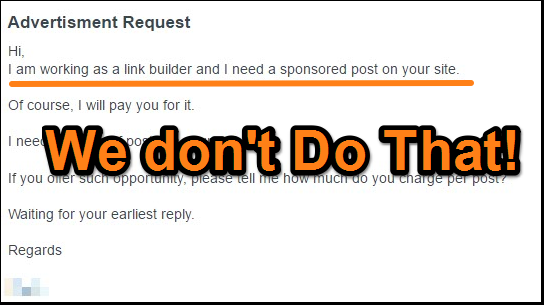
It goes without saying that the additional info is actually the pricing offer. Which takes me back to knowing your audience. Somebody who’s visited our website at least once and had a general idea of what we’re doing would never send such a proposition to us.
Assuming that such a black hat business exists, it still failed to do its research. You cannot email people randomly. This is why Matt Cutts (head of the Web Spam team at Google) got propositions similar to this one – because people don’t do their research.
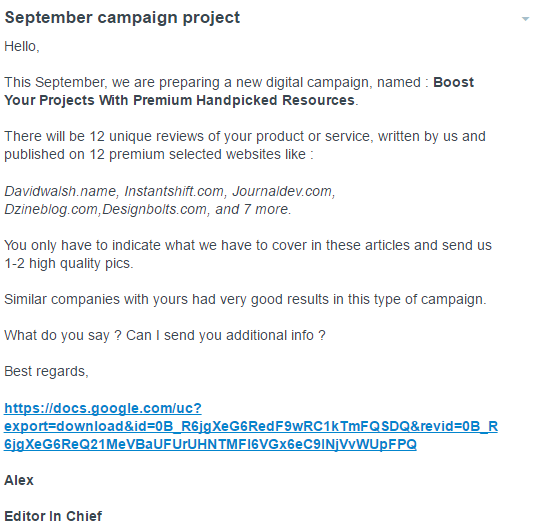
Conclusion
There are many (creative) ways of failing at outreach attempts. However, we hope this list was helpful as to give you a general idea of what’s truly unacceptable. Any other possible mistakes can be worked out through careful practices and a lot of time investment.
What about you? What’s the worst outreach email you’ve ever received?

 Site Explorer
Site Explorer Keyword tool
Keyword tool Google Algorithm Changes
Google Algorithm Changes

Bottom line is my name is not “hi”, “hello”, “Madam” or “sir”.
Livia, I like your analysis and breakdown.
Oh, and Greetings of the Day! 🙂
Rosh